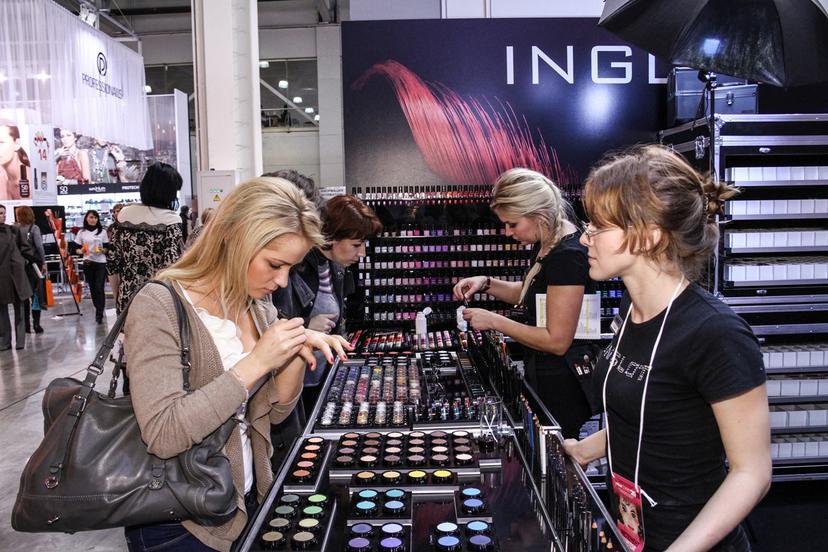Personal Care Products

Background
Beauty Products
As long ago as 3000 B.C., Egyptian kings used cosmetics prepared for them by priests. Toiletries and other luxuries were buried with the kings after they died. When the tombs of these long-dead kings were excavated in modern times, vases of scented ointments were among the items found, with the contents of some still fragrant. The use of cosmetics soon spread to all classes of society. Egyptian women painted their eyebrows, eyelids, and lashes black with kohl (which is made of lead sulfide and other ingredients). Other cosmetics were made of such naturally occurring substances as sesame oil, olive oil, and floral and herbal scents, ingredients that were available to use in simple preparations. Henna was used to add red coloring to the body or hair, and white lead and chalk were used to whiten the complexion.
From the Middle East and the Mediterranean, the use of cosmetics spread through Greece to the Roman Empire and across Europe. In ancient India and medieval Europe, hair and body decoration was practiced only by the upper classes and by members of royalty. Throughout history, everything from beet juice to lethal white lead has been used to decorate the skin and hair. By the 1700s, the men and women of Europe wore stark white face powder, powdered wigs, and bright red lip rouge. Makeup was toned down by the Victorian age; in England, Queen Victoria believed that using makeup was improper, and her attitude came to be adopted by the majority of the English people.
Growing public acceptance of the use of makeup; the development of new manufacturing and packaging techniques for cosmetics; and the emergence of the film industry (which needed makeup for its actors that would not crack or cake) created a great demand for cosmetics in the United States in the early 20th century. In fact, U.S. cosmetics sales increased by 100 percent from 1900 to 1910. Some well-known cosmetics companies that were founded around this time include Max Factor (1904), L’Oréal (1907), and Maybelline (1913).
In the early 20th century, department stores began to sell cosmetics. By the 1920s, the rise of chain, or dime, stores, allowed cosmetics to become available to the general public. After initial resistance, women’s magazines began featuring ads for cosmetics by the late 1920s. Today, new products and production techniques help make the cosmetics industry one of the most successful industries in the United States.
Personal Care and Hygiene Products
Personal hygiene has been part of human life since the early days of civilization. Many ancient cultures had elaborate codes of hygiene, many of which related to preparation for religious activities, the preparation of food, or the prevention of disease. Hygiene practices have varied greatly by culture and era. For example, public bathing facilities were popular in ancient Roman times, while in medieval Europe public bathhouses fell out of favor because of concerns about the spread of disease and immoral behavior.
Some personal-care and hygiene products, such as toothpaste and soap, have existed for thousands of years; others have been invented in the last decade or so. Ancient Egyptians began using a paste to clean their teeth around 5000 B.C. The ancient Romans, Greeks, and Chinese also used toothpaste. The ingredients used by members of these cultures were much different than those contained in modern-day toothpaste. According to a history of toothpaste from the Colgate-Palmolive Company, toothpastes were made of the powder of hooves’ ashes and burnt eggshells that was combined with pumice; crushed bones and oyster shells; powdered charcoal and bark; and salt, ginseng, and herbal mints. The modern production of toothpastes began in the 1800s. These products were typically powders. In 1873, Colgate started the mass production of toothpaste in jars, and in the 1890s, it began to produce toothpaste in tubes. Fluoride toothpastes became available in 1914, and today modern toothpastes fight cavities, whiten teeth, freshen breath, fight plaque, and satisfy any other reasonable need expressed by consumers.
Industrial production of personal-care products began in the 1800s with the production of soap, toothpaste, hair tonics, body lotions, shaving solutions, and other products. In 1806, William Colgate founded Colgate (now Colgate-Palmolive Company) as a soap, starch, and candle business in New York City. Today, the company’s sales surpass $15 billion annually, and its products are available in more than 200 countries and territories. In 1837, Procter & Gamble was founded by candlemaker William Procter and soap maker James Gamble. In 2019, the company had more than $67 billion in sales and operated in 180 countries. Many other personal-care product companies in business today trace their beginnings to the 1800s and early 1900s.
Today, the personal-care and hygiene products sector is a very profitable segment of the U.S. economy, with companies located throughout the United States and around the world.
